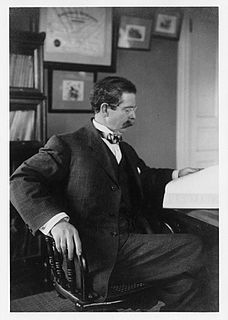
The Dominican Republic is a country in the Caribbean that occupies the eastern five-eighths of Hispaniola. It has an area of 48,670 km2, including offshore islands. The land border shared with Haiti, which occupies the rest of Hispaniola, is 376 km long. The maximum length, east to west, is 390 km from Punta de Agua to Las Lajas, on the border with Haiti. The maximum width, north to south, is 265 km from Cape Isabela to Cape Beata. The capital, Santo Domingo, is located on the south coast.

Hispaniola is an island in the Caribbean that is part of the Greater Antilles. Hispaniola is the most populous island in the West Indies, and the region's second largest in area, after the island of Cuba.

Robert Ridgway was an American ornithologist specializing in systematics. He was appointed in 1880 by Spencer Fullerton Baird, secretary of the Smithsonian Institution, to be the first full-time curator of birds at the United States National Museum, a title he held until his death. In 1883, he helped found the American Ornithologists' Union, where he served as officer and journal editor. Ridgway was an outstanding descriptive taxonomist, capping his life work with The Birds of North and Middle America. In his lifetime, he was unmatched in the number of North American bird species that he described for science. As technical illustrator, Ridgway used his own paintings and outline drawings to complement his writing. He also published two books that systematized color names for describing birds, A Nomenclature of Colors for Naturalists (1886) and Color Standards and Color Nomenclature (1912). Ornithologists all over the world continue to cite Ridgway's color studies and books.

Leonhard Hess Stejneger was a Norwegian-born American ornithologist, herpetologist and zoologist. Stejneger specialized in vertebrate natural history studies. He gained his greatest reputation with reptiles and amphibians.

Ridgway's hawk(Buteo ridgwayi) is a bird of prey in the family Accipitridae endemic to the island of Hispaniola in the Caribbean. It is classified as Critically Endangered because of habitat destruction and human persecution in the Dominican Republic; however, due to conservation efforts, the population is now increasing.

Frank Alexander Wetmore was an American ornithologist and avian paleontologist. He was the sixth Secretary of the Smithsonian Institution.

The Hispaniolan solenodon, is a solenodon endemic to the Caribbean island of Hispaniola. It was first described by Johann Friedrich von Brandt in 1833. A similar but smaller species, Marcano's solenodon (S. marcanoi), once lived on the island, but became extinct after European colonization. Along with the often sympatric Hispaniolan hutia, it is one of two extant native land mammals on Hispaniola.

The Hispaniolan Ornithological Society, is a non-profit environmental organization dedicated to nature conservation, particularly of birds and their habitats, on the island of Hispaniola. SOH's mission is to "conserve Hispaniolan birds and their habitats through research, community education, and professional training".

The EBCC Atlas of European Breeding Birds - their distribution and abundance (ISBN 0-85661-091-7) is an ornithological atlas published for the European Bird Census Council by T & A D Poyser in 1997. Its editors were Ward J. M. Hagemeijer and Michael J. Blair. The atlas was the first to present grid-square distribution maps for all breeding birds at a Europe-wide level. The bulk of the book is in English, although it also contains introductions in thirteen other European languages. The atlas presents the results of the European Bird Census Council's European Ornithological Atlas project, the fieldwork for which was carried out between 1985 and 1988.

The golden swallow is a swallow endemic to the Caribbean island of Hispaniola and was once native to Jamaica, but is now extirpated there. It is restricted to isolated montane forests that primarily consist of the Hispaniolan pine. This species is considered to be a vulnerable species by the International Union for Conservation of Nature (IUCN). The exact cause of its extirpation from Jamaica is unknown, but likely factors include predation by introduced mammals and habitat loss, although the habitat loss theory is not supported by much evidence. The last sighting of the nominate subspecies was in Hardwar Gap, with three birds being seen on 8 June 1989.

The Hispaniolan nightjar is a nightjar species endemic to the Caribbean island of Hispaniola, which is shared by the Dominican Republic and Haiti.

The tawny-shouldered blackbird is a species of bird in the family Icteridae. It is found in Cuba and Hispaniola. It is a vagrant in the United States.

The red-legged thrush is a species of bird in the family Turdidae. Native to the Caribbean, it is found in the Bahamas, Cayman Islands, Cuba, Dominica, Hispaniola and Puerto Rico. It formerly occurred on the Swan Islands, Honduras, but was extirpated there.

The Hispaniolan trogon is a species of bird in the family Trogonidae. It is endemic to Hispaniola in the Caribbean. It is one of the only two trogon species found in the Caribbean. It is the national bird of Haiti.
Paleontology or palaeontology is the study of prehistoric life forms on Earth through the examination of plant and animal fossils. This includes the study of body fossils, tracks (ichnites), burrows, cast-off parts, fossilised feces (coprolites), palynomorphs and chemical residues. Because humans have encountered fossils for millennia, paleontology has a long history both before and after becoming formalized as a science. This article records significant discoveries and events related to paleontology that occurred or were published in the year 1976.
William Louis Abbott was an American medical doctor, explorer, ornithologist and field naturalist. He compiled prodigious collections of biological specimens and ethnological artefacts from around the world, especially from Maritime Southeast Asia, and was a significant financial supporter of the United States National Museum collecting expeditions.

The Baird Ornithological Club is a United States ornithological club. Founded in 1921, the club seeks to advance the field of ornithology and foster relationships between fellow ornithologists. The organization was named after Spencer Fullerton Baird. The organization was founded by Earl Lincoln Poole and Harold Morris in Berks County, Pennsylvania.
Harry Kirke Swann was an English ornithologist and author of books on birds. His research interests were birds of prey and British avifauna.

Annie Beatrice van der Biest Thielen Wetmore, widely known as Bea Wetmore, was a Curaçaoan-American ornithologist and benefactor.














